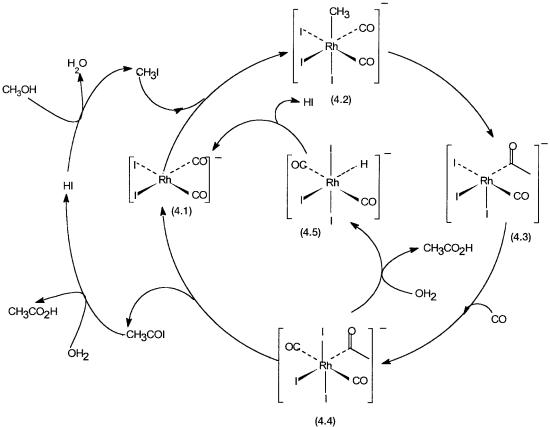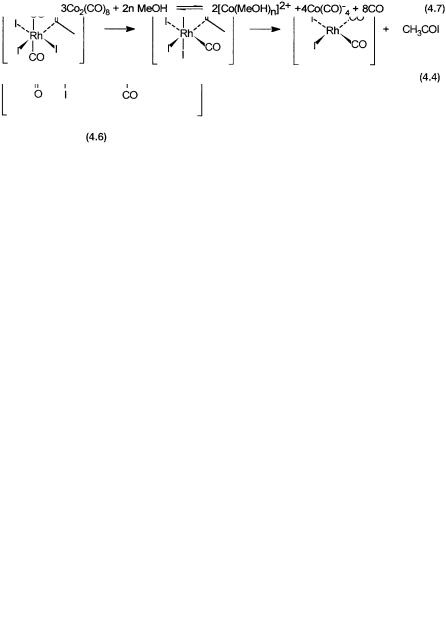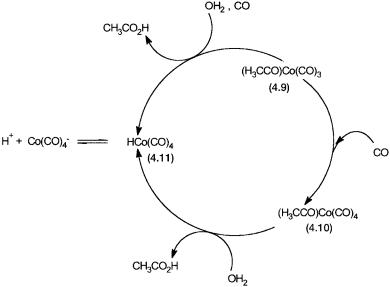
Homogeneous Catalysis
.pdfPROBLEMS 53
hot fluid inlet = 120 C; outlet = 90 C. Cold fluid inlet = 30 C, outlet = 43 C. Q = UA Tln, where Tln = ( T2 T1)/ln( T2 / T1). For countercurrent T2 = temperature of hot fluid in temperature of cold fluid out. T1 = temperature of hot fluid out temperature of cold fluid in.
Ans. 2.2 m2.
7.Repeat this problem for a cocurrent (parallel) flow shell and tube heat exchanger. Here T2 = temperature of hot fluid in cold fluid in. T1 = temperature of hot fluid out cold fluid out.
Ans. 2.6 m2.
8.State the methods of avoiding vortex in a liquid under agitation. What are the disadvantages of vortex formation?
Ans. Vortex can be avoided (a) by providing baffles in the tank; (b) by placing the agitator off-center; and (c) by providing an extra set of flat-blade agitators at the surface of the liquid. The vortex leads to improper agitation and (b) ingress of gas from the space above the liquid due to the creation of a vacuum.
9.In a distillation column a vent is usually provided at the top of the condenser. What will happen if the rate of vaporization is increased above that for which the condenser is designed?
Ans. Uncondensed vapor will escape.
10.The driving force for heat transfer is the temperature difference. What is the driving force for mass transfer?
Ans. The concentration difference.
11.Ammonia is to be absorbed from a mixture of ammonia and air in an absorption tower (countercurrent) using water as the solvent. The conditions are as follows: Air flow rate (V) = 200 kg/h. Liquid-phase compositions: at the top of the packing (x2) = 0.000013 kg NH3/kg H2O; at the bottom of the packing (x1) 0.0006 kg NH3/kg H2O. Gas-phase composition: at the bottom of the packing (y1) = 0.0084 kg NH3/kg of gas; at the top of the packing (y2) = 0.00044 kg NH3/kg gas. Calculate the flow rate of water (L).
Ans. Carry out a mass balance for ammonia. Ammonia entering the column with the gas-ammonia leaving the column with the gas = ammonia leaving the column with the liquid–ammonia entering the column with the liquid. V(y1 y2) = L(x1 x2). 1362.86 kg/h.
12. In a stirred vessel, power input (P) to ghe agitator is proportional to N2i D3i (in laninar regime) and N3i D5i in the turbulent region. During aeration power input (Pa) to the agitator is proportional to [P2(Ni D3i )0.44/N0.56a ]0.45 (Ni and Di are the stirrer rpm and diameter, P, the power input in the absence
54 CHEMICAL ENGINEERING FUNDAMENTALS
of aeration, Na = Q/NiD3i , Q the aeration flow rate). (a) How will motor power vary with aeration rate? (b) Compare motor power during aeration and without aeration for varying stirrer rpm and explain your results.
Ans. (a) Increasing aeration decreases power requirement for agitation; (b) rpm has a larger effect on Pa than P, since power is consumed in shearing the air bubbles.
BIBLIOGRAPHY
Books for all the sections
Unit Operations of Chemical Engineering, 5th ed., W. L. McCabe and J. C. Smith, McGraw-Hill, New York, 1993.
Process Heat Transfer, D. Q. Kern, McGraw-Hill, New York, 1950.
Unit Operations I and II, K. A. Gavhane, Nirali Prakashan, Pune, 1992.
Fluid Mixing Technology, Chemical Engineering, J. Y. Oldshue, McGraw-Hill, New York, 1983.
Article
M.Baerns and P. Claus, in Applied Homogeneous Catalysis, edited by B. Cornils and W. A. Herrmann, VCH, Weinheim, New York, 1996, vol 2, 684–98.

Homogeneous Catalysis: Mechanisms and Industrial Applications
Sumit Bhaduri, Doble Mukesh
Copyright 2000 John Wiley & Sons, Inc.
ISBNs: 0-471-37221-8 (Hardback); 0-471-22038-8 (Electronic)
CHAPTER 4
CARBONYLATION
4.1INTRODUCTION
In this chapter we discuss the mechanistic and other details of a few industrial carbonylation processes. These are carbonylation of methanol to acetic acid, methyl acetate to acetic anhydride, propyne to methyl methacrylate, and benzyl chloride to phenyl acetic acid. Both Monsanto and BASF manufacture acetic acid by methanol carbonylation, Reaction 4.1. The BASF process is older than the Monsanto process. The catalysts and the reaction conditions for the two processes are also different and are compared in the next section. Carbonylation of methyl acetate to acetic anhydride, according to reaction 4.2, is a successful industrial process that has been developed by Eastman Kodak. The carbonylation of propyne (methyl acetylene) in methanol to give methyl methacrylate has recently been commercialized by Shell. The Montedison carbonylation process for the manufacture of phenyl acetic acid from benzyl chloride is noteworthy for the clever combination of phase-transfer and organometallic catalyses. Hoechst has recently reported a novel carbonylation process for the drug ibuprofen.
CH3OH CO → CH3CO2H, |
H = 136.6 kJ/mol |
(4.1) |
CH3CO2CH3 CO → (CH3CO)2O, |
H = 94.8 kJ/mol |
(4.2) |
In this chapter we also discuss two other catalytic reactions that involve CO as one of the reactants. These are the water-gas shift (see Section 1.2) and Fischer–Tropsch reactions. Although for these reactions homogeneous catalysts are not used industrially, for explaining the formation of by-products in the
55

56 CARBONYLATION
Monsanto and BASF processes, they are relevant. Many of the fundamental concepts discussed in Chapter 2 are neatly illustrated by the methanol carbonylation reactions. We begin our discussion with these reactions.
4.2MANUFACTURE OF ACETIC ACID
Some of the process parameters for methanol carbonylation processes are compared in Table 4.1.
The main byproduct forming reactions in the BASF and Monsanto processes are different. In the former it is the liquid phase Fischer–Tropsch-type reaction, that leads to the formation of products such as such as alkyl acetates, methane etc. In the Monsanto process it is the homogeneous water-gas shift reaction that produces CO2 and H2 as byproducts. Also note that the Monsanto process is superior in terms of selectivity, metal usage and operating conditions.
4.2.1The Monsanto Process—The Catalytic Cycle
The basic catalytic cycles and the catalytic intermediates for the Monsanto process are shown in Fig. 4.1. A variety of rhodium salts may be added to the reaction mixture as precatalysts. In the presence of I and CO they are quickly converted to complex 4.1. The following points about the catalytic cycles deserve special attention.
First, the organometallic and organic catalytic steps are shown separately in
(a) and (b), respectively. In Fig. 4.2 these two loops are combined. In this diagram there is also one extra catalytic intermediate (4.5). This is involved in
TABLE 4.1 Comparison of Process Parameters for Methanol Carbonylation Processes
|
BASF |
Monsanto |
|
|
|
Metal concentration |
10 1 mole/liter of |
10 3 mole/liter of rhodium |
|
cobalt |
|
Temperature |
230 C |
180–190 C |
Pressure (atm) |
500–700 |
30–40 |
Selectivity (%) based on |
|
|
1. Methanol |
90 |
>99 |
2. CO |
70 |
90 |
Byproducts |
CH4, glycol acetate, and |
CO2, H2 |
|
other oxygenated |
|
|
hydrocarbons |
|
Effect of hydrogen |
Amount of byproduct |
No effect |
|
increases |
|
Promoter CH3I |
Essential |
Essential |
|
|
|

Figure 4.1 Monsanto process. (a) The organometallic catalytic cycle; CH3I and CO react to give CH3COI. (b) The organic catalytic cycle; water and HI act as catalysts to generate acetic acid and CH3I from CH3COI and methanol.
57

58
Figure 4.2 Monsanto process: The organic and organometallic cycles are combined. The inner cycle shows an additional pathway for product formation.
MANUFACTURE OF ACETIC ACID |
59 |
an additional product-forming pathway. Second, 4.1 to 4.2 is an oxidative addition reaction, 4.2 to 4.3 is an insertion reaction, and 4.4 to 4.1 is a reductive elimination reaction. Third, 4.1 and 4.3 are 16-electron complexes, while 4.2, 4.4, and 4.5 have electron counts of 18. Finally, the stoichiometry of the overall reaction is that of reaction 4.1; methanol and CO are the only two reactants that irreversibly enter the loops.
Acetyl iodide is the real product of the primary catalytic cycle. Water, though required for the hydrolysis of acetyl iodide, is generated in the reaction of methanol with HI. It is therefore not involved in the overall stoichiometry. To make the cycle operational, small amounts of CH3I and water are added in the beginning.
4.2.2Mechanistic Studies and Model Compounds
The rate of methanol carbonylation shows zero-order dependence on the concentration of methanol, carbon monoxide, and acetic acid. As shown, it is first order with respect to the concentrations of rhodium and methyl iodide:
rate = [Rh][CH3I] |
(4.3) |
The rate-determining step in the catalytic cycle is the oxidative addition of CH3I to 4.1. Oxidative additions of alkyl halides are often known to follow SN2 mechanisms. This appears to be also the case here. The net negative charge on 4.1 enhances its nucleophilicity and reactivity towards CH3I.
In situ IR spectroscopy of the reaction mixture at a pressure and temperature close to the actual catalytic process shows the presence of only 4.1. As we will see, all the other complexes shown in the catalytic cycle (i.e., complexes 4.2– 4.5) are also seen by spectroscopic methods under milder conditions. Under the operating conditions of catalysis they are not observed by IR spectroscopy, as their concentrations are much less compared to that of 4.1.
Regardless of the initial source of rhodium, that is, whether it is added just as a halide or as a phosphine complex, under the reaction conditions 4.1 is formed. With phosphine complexes, the phosphine is converted to a phosphonium (PR4 or HPR3 ) counter-cation. As chelating phosphines bind more strongly than the monodentate ones, the induction time for the formation of 4.1 with chelating phosphines is longer.
At ambient temperatures and in neat CH3I as a solvent, IR bands and NMR signals for complexes 4.2–4.4 are seen. The stereochemistry of 4.2 as shown in the catalytic cycle is consistent with the spectroscopic data. The relative thermodynamic and kinetic stabilities of complexes 4.1–4.3 under these conditions have also been estimated. The data show that 4.2 is unstable with respect to conversion to both 4.3 and 4.1. In other words, 4.2 undergoes facile insertion and reductive elimination reactions.
The spectral characteristic of 4.3 in solution is indicative of the presence of a mixture of isomers in solution. From the reaction of CH3I with 4.1, under

60 CARBONYLATION
noncatalytic conditions, a solid has been isolated. The structure of this compound is as shown in 4.6. It is clear that 4.6 is a dimer of 4.3. In other words, under noncatalytic conditions (absence of external CO), 4.1 reacts with CH3I to give 4.3, which then dimerizes to produce the stable compound.
Reaction of 4.6 with CO has been investigated by spectroscopy (IR and NMR) and product analyses. The final products of this reaction are 4.1 and CH3COI. In this conversion of 4.6 to 4.1, there is spectroscopic evidence to suggest the formation of an intermediate complex like 4.4 in solution. In fact, by carrying out low-temperature NMR studies on 13C-labeled compound, the sequence as shown by 4.4, has been suggested.
Finally, complex 4.5 can be made from the oxidative addition of HI onto 4.1. The suggestion that 4.4 reacts with water to form acetic acid and 4.5 is therefore a reasonable one. In summary, there is excellent evidence for all the catalytic intermediates shown in the proposed cycle.
4.2.3The BASF Process—The Catalytic Cycle
The basic steps of the catalytic cycle with the cobalt catalyst are shown in Fig. 4.3. The tetracarbonyl cobalt anion 4.7 is formed from cobalt iodide, by reactions 4.5–4.7.

MANUFACTURE OF ACETIC ACID |
61 |
Figure 4.3 BASF process: The catalytic cycle for the conversion of CH3I plus CO to CH3COI. The organic cycle is not shown and is the same as in Figs. 4.1 and 4.2.
A nucleophilic attack by 4.7 on CH3I produces 4.8 and I . Conversion of 4.8 to 4.9 is an example of a carbonyl insertion into a metal alkyl bond. Another CO group adds onto the 16-electron species 4.9 to give 4.10, which in turn reacts with I to eliminate acetyl iodide. Formation of acetic acid and recycling of water occur by reactions already discussed for the rhodium cycle. Apart from these basic reactions there are a few other reactions that lead to product and by-product formations. As shown in Fig. 4.4, both 4.9 and 4.10 react with water to give acetic acid. The hydrido cobalt carbonyl 4.11 produced in these reactions catalyzes Fischer–Tropsch-type reactions and the formation of byproducts. Reactions 4.6 and 4.7 ensure that there is equilibrium between 4.7 and 4.11.
There are two main differences between cobaltand rhodium-based catalytic cycles. In the cobalt-catalyzed cycle it is the nucleophilic attack by 4.7 on CH3I rather than the oxidative addition of CH3I on any unsaturated 16-electron species that initiates the catalytic cycle. Second, in the rhodium cycle reductive elimination generates acetyl iodide, whereas in the cobalt cycle it is the attack by I on 4.10 that produces acetyl iodide. Thus oxidative addition and reductive elimination steps are not involved in the cobalt cycle, but play crucial roles in the rhodium cycle.
4.2.4BASF Process—Mechanistic Studies
The rate of cobalt-catalyzed carbonylation is strongly dependent on both the pressure of carbon monoxide and methanol concentration. Complex 4.7, unlike 4.1, is an 18-electron nucleophile. This makes the attack on CH3I by 4.7 a comparatively slow reaction. High temperatures are required to achieve acceptable rates with the cobalt catalyst. This in turn necessitates high pressures of CO to stabilize 4.7 at high temperatures.

62 CARBONYLATION
Figure 4.4 Pathways that lead to the generation of HCo(CO)4 and an equilibrium between this species and Co(CO)4 .
Spectroscopic studies under actual operating conditions have not been reported. However, 4.7, 4.8, 4.10, and 4.11 are well-characterized complexes. Evidence for the intermediate 4.9 comes from kinetic studies. The structure of 4.11 has also been determined by electron diffraction. X-ray structural data are available for Co(C2F4H)(CO)3L, a model of 4.8.
4.3 WATER-GAS SHIFT REACTION AND RHODIUMCATALYZED CARBONYLATION
The relevance of the water-gas shift reaction in the petrochemical industry has already been discussed (see Section 1.1). The significance of the water-gas shift reaction in homogeneous systems is twofold. First, it plays a crucial role in stabilizing the rhodium catalyst in the Monsanto process. Second, studies carried out in homogeneous systems employing metals other than rhodium have provided useful mechanistic insights into the heterogeneous water-gas shift reaction. We first discuss the catalytic cycle with 4.1 as one of the catalytic intermediates, and then mechanistic results that are available from an iron-based catalytic system.
The proposed catalytic cycle for the water-gas shift reaction in the Monsanto process is shown in Fig. 4.5. This cycle operates at acidic pH and is responsible for CO2 and H2 production. It has a useful function in stabilizing the rhodium
